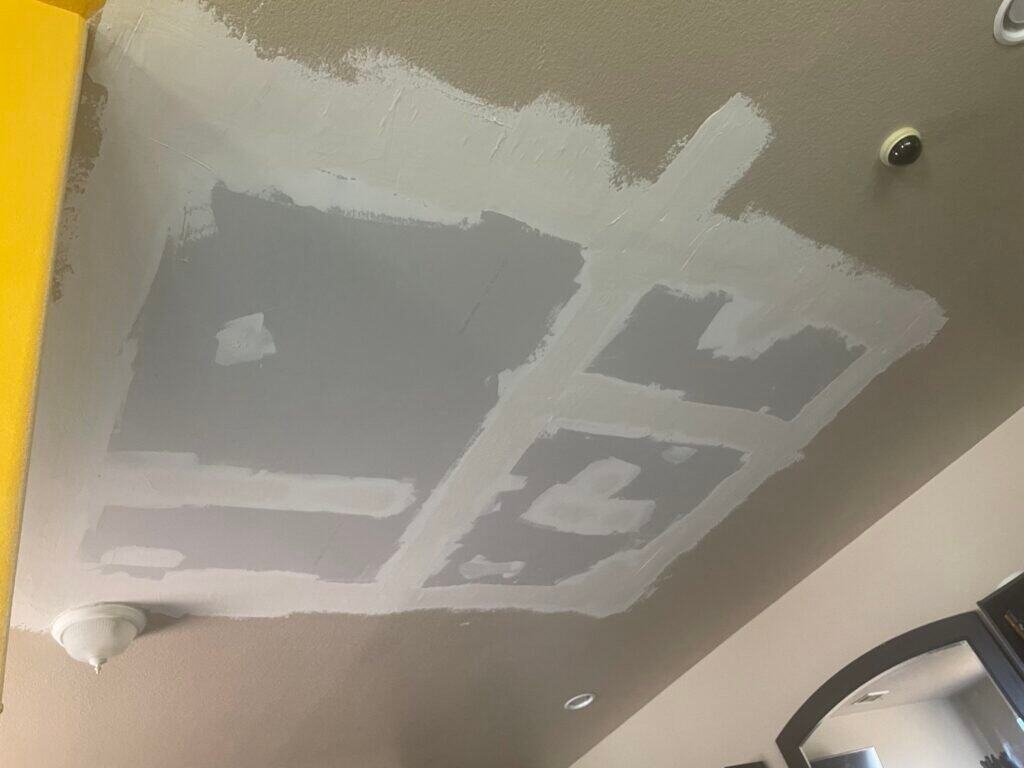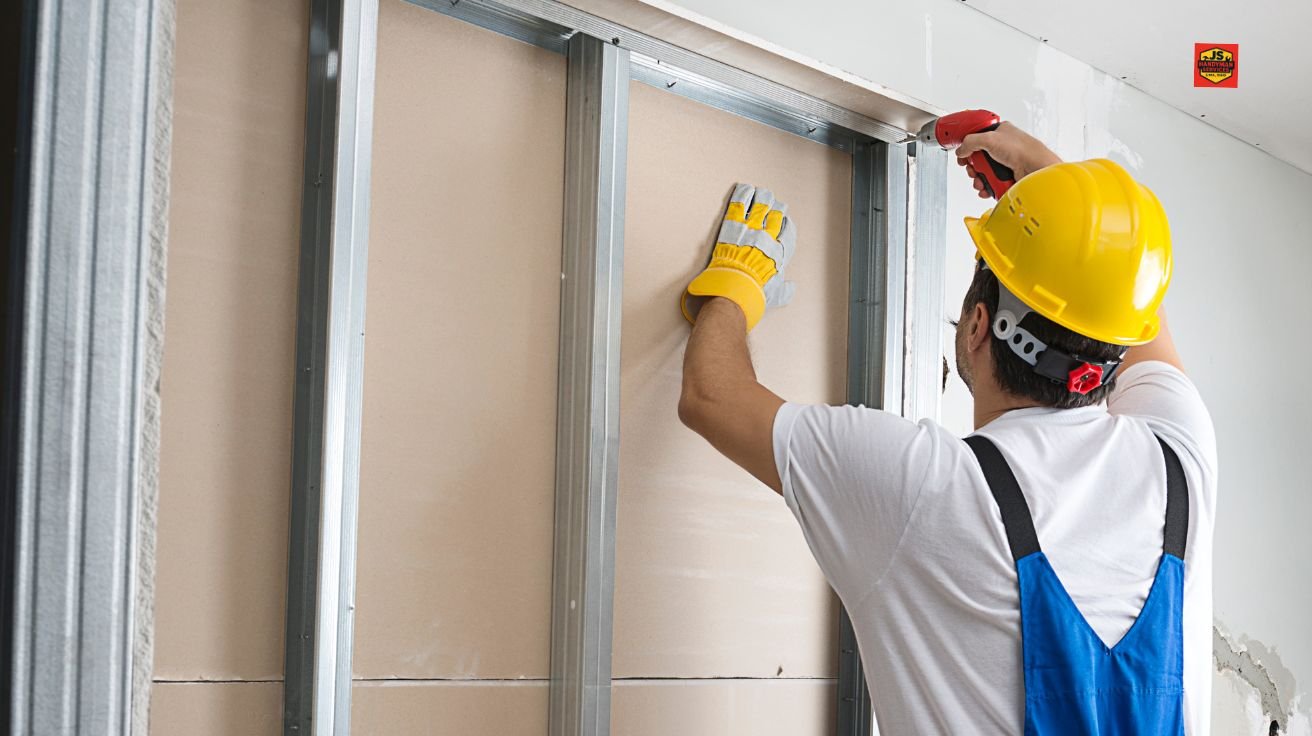Discover the very best Practices for Successful Drywall Repair Work and Setup
The art of drywall repair service and setup needs a mix of skill and accuracy. Understanding the vital devices is important for accomplishing a seamless surface. Comprehending the step-by-step process can make a considerable distinction in the outcome. Appropriate strategies for taping and mudding are additionally critical. What continues to be is the understanding of upkeep that ensures durability. These components together produce a refined outcome worth exploring further.
:max_bytes(150000):strip_icc()/SPR-solutions-to-common-drywall-problems-p2-4120949-hero-c15a37669eae45478eca0cf15b34a1d1.jpg)
Essential Devices for Drywall Repair and Installment
When embarking on drywall repair and installment, having the right tools can substantially improve the performance and top quality of the work. An energy blade is vital for reducing drywall sheets exactly, while a drywall saw can aid in making much more detailed cuts. Taping blades, readily available in different sizes, are vital for using joint compound efficiently and uniformly. A drywall sander, ideally with a dirt collection function, helps attain a refined coating, minimizing the need for comprehensive cleanup.
In addition, a measuring tape warranties precise measurements, and a level makes sure that setups are straight and plumb. Security gear, including dirt masks and goggles, should not be forgotten to secure against particles and dust. A stud finder aids in finding framing members, guaranteeing safe installment. By outfitting oneself with these vital devices, the repair work and installation process becomes a lot more workable and leads to a professional-quality end result.

Step-by-Step Guide to Patching Holes
Covering holes in drywall calls for a systematic approach to ensure a seamless repair work. The location around the opening should be cleaned and any type of loose particles eliminated. For small holes, a putty blade can be utilized to use a light-weight spackle, pressing it right into the hole and smoothing the surface area. After it dries, fining sand is vital to create a level coating. For larger holes, a spot of drywall may be essential. This involves reducing a piece of drywall a little larger than the opening, securing it to the wall surface with screws, and making use of joint compound to cover the joints. Once the substance dries, it must be fined sand smooth. Lastly, topping the patched area prior to paint will assure an even coating. Complying with these steps will certainly cause a professional-looking repair work that mixes effortlessly with the surrounding wall.
Strategies for Smooth Drywall Installation
Attaining seamless drywall installation needs mindful planning and implementation. First, it is vital to gauge and cut drywall sheets precisely to minimize spaces. Using an energy knife, installers need to score the board before snapping it along the cut line, making sure tidy sides. Effectively aligning the sheets is crucial; beginning from the leading and working down assists preserve uniformity.
Securing drywall to the studs needs regular spacing, typically every 16 inches, utilizing screws instead than nails for far better hold. This approach reduces the danger of stands out over time. Furthermore, surprising the joints in between sheets improves architectural honesty and reduces the visibility of joints.
Lastly, utilizing the best thickness of drywall for specific locations-- such as moisture-resistant key ins washrooms-- more adds to a perfect surface. Adhering to these methods will lead to a smooth and professional-looking installation, establishing the stage for the subsequent ending up processes.
Ending Up Touches: Insulation and Mudding
Completing touches, such as taping and mudding, play a vital role in attaining a refined drywall surface. Insulation includes using a slim strip of drywall tape over the joints and joints, ensuring a smooth appearance. This process aids stop splits and develops a solid bond in between drywall sheets. It is essential to select the right kind of tape, with paper and fiberglass harmonize being one of the most typical options.
Mudding, or using joint compound, adheres to taping. This compound fills up in spaces and ravel the surface for an uniform coating. It is normally applied in several layers, with each coat needing to dry before sanding. Appropriate technique entails feathering the sides to blend the substance into the bordering drywall, reducing exposure.
When finished correctly, taping and mudding improve both the structural and aesthetic stability of the drywall installation, leading to a professional-quality surface.
Tips for Keeping Your Drywall After Installment

In addition, maintaining a constant interior humidity level can prevent bending or mold growth. Using a dehumidifier in wet areas, like cellars, is suggested. It's likewise advantageous to occasionally repaint areas that reveal wear, as this protects the underlying material. When moving furnishings or installing fixtures, care ought to be worked out to stay clear of damaging the drywall. By complying with these upkeep tips, property owners can expand the life of their drywall, protecting it continues to be an attractive function of their insides.
Regularly Asked Questions
What Safety Gear Is Needed for Drywall Fixing and Setup?
For drywall repair service and installment, essential security gear includes security goggles to secure eyes, dust masks to stop breathing of fragments, handwear covers for hand defense, and knee pads for convenience throughout long term kneeling. Drywall Repair Ogden UT.
Exactly how Do I Determine the Drywall Thickness Needed for My Project?
To determine the drywall thickness required for a job, one must take into here consideration the wall surface's architectural needs, neighborhood structure codes, and the meant use the area, usually going with 1/2-inch or 5/8-inch drywall.
Can I Repair Drywall Without Removing Furniture From the Area?
Yes, drywall can be repaired without getting rid of furnishings from the room. Careful planning and protective steps can decrease mess, permitting efficient repair services while keeping surrounding products risk-free from dust and damage throughout the procedure.
What Types of Drywall Are Best for Various Settings?
Moisture-resistant drywall is suitable for kitchens and washrooms, while soundproof drywall fits shared walls in homes. Fire-rated drywall is best for garages, and typical drywall works well as a whole living locations, making sure toughness and viability for numerous environments.
The length of time Does It Take for Drywall Mud to Dry Totally?
Drywall mud usually takes 24 to 2 days to dry completely, relying on aspects like humidity and temperature (Interior Painting). Thicker applications may need longer drying out times, while thinner layers can dry quicker. Appropriate ventilation aids drying out
The art of drywall repair and setup calls for a blend of ability and accuracy. When taking on drywall repair work and installment, having the right tools can considerably boost the efficiency and high quality of the job. An utility knife is crucial for cutting drywall sheets exactly, while a drywall saw can aid in making more complex cuts. Attaining smooth drywall installation demands cautious preparation and execution. Moisture-resistant drywall is suitable for kitchen areas and shower rooms, while soundproof drywall matches shared wall surfaces in apartments.